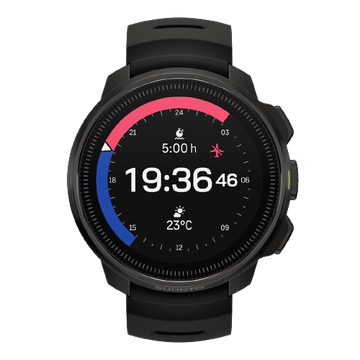Keep an eye on what's happening inside your muscles with a Train.red muscle oxygen sensor and your Suunto watch.
Exercise technology is developing fast and new ways to measure and understand what is going on in our bodies emerge frequently. SuuntoPlus gives sensor companies an agile way to integrate with Suunto watches for real-time monitoring and data collection. The latest addition to compatible devices is Train.Red muscle oxygen sensor.
Muscle oxygen sensors are tiny devices that monitor the level of oxygen saturation in the muscles. The concentration of oxygenated and deoxygenated hemoglobin in muscle tissue is commonly measured using near-infrared spectroscopy (NIRS) devices. These sensors provide valuable data by detecting the saturation of oxygen in the muscle, which can assist athletes in maximizing their performance and recovery.
How Muscle Oxygen Sensors Work
Muscle oxygen sensors work by emitting light into the muscle tissue and measuring the amount of light that is absorbed and scattered by the hemoglobin in the muscle. This allows the sensor to determine the concentration of oxygenated and deoxygenated hemoglobin in the muscle tissue, which can be used to calculate the oxygen saturation level.

When using SuuntoPlus Train.red sport app your TrainRed muscle oxygen sensor will provide real-time feedback on the oxygenation status of muscles.
The Advantages of Muscle Oxygen Sensors in sports
Performance Evaluation
One of the key advantages of sports muscle oxygen sensors is that they provide vital data on an athlete's performance. Athletes can receive insight into how their bodies are doing and how they can enhance their performance by monitoring the saturation of oxygen in the muscles during exercise.
Improving Endurance
Muscle oxygen sensors can also be used to improve endurance. By monitoring the oxygen saturation levels in the muscles during exercise, athletes can determine when their muscles are becoming fatigued and adjust their training accordingly. This can help athletes train more efficiently and effectively, leading to greater gains in endurance and overall performance.
Avoiding Injury
Muscle oxygen sensors can potentially be utilized to aid in injury prevention. Athletes can tell whether their muscles are exhausted and at risk of injury by monitoring the oxygen saturation levels in their muscles. This enables them to modify their training to avoid injury and retain optimal performance.
Personalized Training
Muscle oxygen sensors can also be used to create personalized training plans. By analyzing the data provided by the sensors, athletes and coaches can identify areas of weakness and develop training plans that are tailored to their specific needs. This can lead to more efficient training and greater gains in performance.
Monitoring the Recovery Process
Finally, muscle oxygen sensors can be employed to track recovery progress. Athletes can evaluate how quickly their muscles recover by measuring the oxygen saturation levels in their muscles after exercise and adjusting their training accordingly. This can aid in the prevention of overtraining and injury, resulting in more consistent performance over time.
How to use Train.red with Suunto
When using SuuntoPlus Train.red sport app your TrainRed muscle oxygen (SmO2%) sensor will provide real-time feedback on the oxygenation status of muscles, helping you optimize your training and performance.
- Go to Suunto app’s App Store and save Train.red sport app in your sport apps.
- Go to “My SuuntoPlus sport apps” and “install” the Train.red sport app.
- Sync your watch with the app
- Before starting an activity, go down to the exercise settings and select Train.red sport app.
- During activity your Train.red data will be shown on a specific Train.red screen.
- After the activity your muscle oxygen data is saved and synced to Suunto app for post-exercise analysis.
































































































